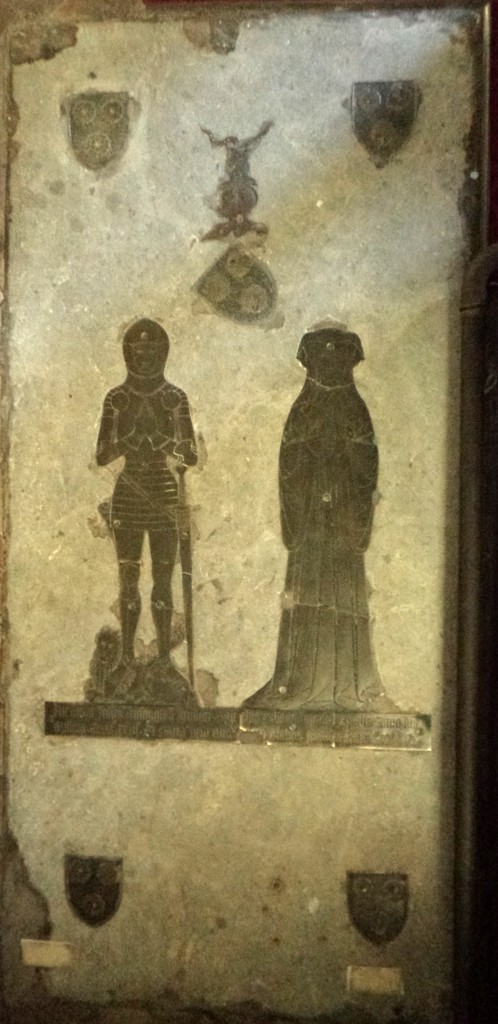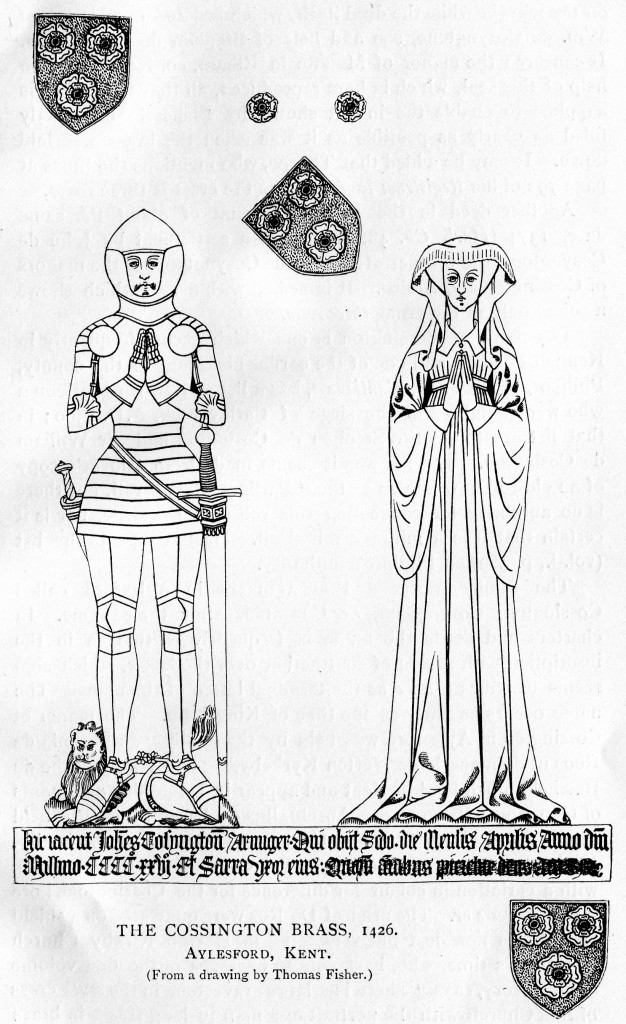John and Sara Cossington
- Date of Brass:
- 1426
- Place:
- Aylesford
- County:
- Kent
- Country:
- Number:
- I
- Style:
- London B
Description
October 2023
The artist and antiquary Thomas Fisher was born in 1772 in Rochester, Kent. His work encompassed far more than monumental brasses, but his contribution in this field was particularly valuable, especially in regard to the brasses of Bedfordhire and Kent. He worked from dabbings and rubbings that he had made, and in the first third of the nineteenth century recorded many brasses that have since been lost or damaged.
At Aylesford in Kent he first sketched the Cossington brass, as was his custom, showing the whole slab with its brass inlays and the indents of items already missing. He also, separately, carefully drew the brass inlays at a much larger scale. The brass commemorates John Cosyngton (Cossington) and his wife Sarra (Sara). John died on 2 April 1426. His is a typical armoured figure in London style B, in complete plate of the sort introduced during the 1410s. Sarra’s attire is also typical of the period, with a high-waisted belted gown with buttons to the neck (visible above her hands) and sleeves gathered at her wrists but falling voluminously to below her hips. Her hair is gathered into horns either side of her head and covered with an ample veil that falls to her shoulders.
When Fisher drew the brass, only three of the original five shields remained, all displaying the Cossington arms, Azure three roses or. Sarra’s family’s arms are not shown, unless they were on either of the lost shields. Interestingly Ralph Griffin, writing about this brass in the MBS Transactions, volume 6 part 7 (March 1913), noted that John Weever did not record any inscriptions at Aylesford, but gave an inscription at "Otteham" (Otham) that corresponds almost exactly to this one at Aylesford, including the same date of death. John’s surname is transcribed by Weever as "Constenton", and Sarra’s surname is given as Conghurst, but otherwise the details are the same. John’s surname is thus very similar to "Cosenton", as Cossington was sometimes spelt. Griffin also noted that it was not unknown for Weever to allocate an inscription to the wrong church. Otham is a few miles from Aylesford on the other side of Maidstone. If Weever had simply muddled the names of his churches, he presumably had other information - perhaps one of the missing shields - to tell him Sarra was a Conghurst.
The brass at Aylesford has been restored. The helmet and crest now have a rather different form from the original, putting a goat’s head crest on a rather later-looking helmet. John held the manor of Cossington in Aylesford, as his ancestors had for generations. It is not clear why the couple were commemorated by a brass as they were not the last of the family, being succeeded by Stephen Cosyngton, although it is not clear whether he was a son, a nephew or other relation. The family eventually died out in the reign of Henry VIII.
The inscription of the brass in expanded form reads:
Hic iacent Johannes Cosyngton Armiger Qui Obijt Secundo die mensis Aprilis Anno domini
Millesimo CCCCxxvi Et Sarra uxor eius Quorum animabus propicietur deus AMEN
which translates as:
Here lie John Cossington Esquire, who died the second day of April 1426, and Sarah his wife, on whose souls may God have mercy, Amen.
The concluding prayer has been rather ineffectively scored out, probably in the 1640s.
Copyright: Jon Bayliss, text and photograph
- © Monumental Brass Society (MBS) 2025
- Registered Charity No. 214336




